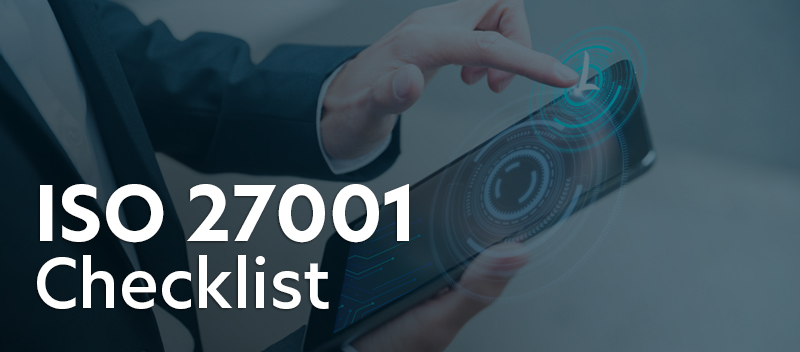Blog The ISO 27001 Checklist for Your Business
The ISO 27001 Checklist for Your Business

ISO 27001, an internationally recognized standard for information security management systems (ISMS), provides a robust framework to protect your organization’s data. This article explores the fundamentals of ISO 27001, emphasizing its importance and providing a thorough checklist to guarantee that your company reaches and keeps compliance. Businesses may reduce risks, increase consumer trust, and show that they are committed to data security by following ISO 27001 standards.
Understanding ISO 27001 Requirements
To effectively implement ISO 27001, it’s crucial to understand its key requirements.
1. Information Security Management System (ISMS)
The core of ISO 27001 revolves around the establishment and maintenance of an ISMS. This system encompasses policies, procedures, and controls tailored to your organization’s specific needs. Key elements include:
-
- Scope Definition: Clearly outline the boundaries and applicability of the ISMS.
-
- Information Security Policies: Develop comprehensive policies that address information security objectives.
-
- Risk Assessment Framework: Implement a systematic approach to identify, evaluate, and mitigate risks.
2. Risk Assessment and Treatment
Risk assessment is a fundamental part of ISO 27001, involving the identification and evaluation of potential threats to your information assets. The process includes:
-
- Asset Identification: Catalog all information assets within the scope of the ISMS.
-
- Threat and Vulnerability Analysis: Identify potential threats and vulnerabilities affecting these assets.
-
- Risk Evaluation: Assess the likelihood and impact of each identified risk.
-
- Risk Treatment Plan: Develop and implement measures to mitigate or manage these risks, such as deploying security controls or accepting residual risks.
3. Leadership and Commitment
Strong leadership and commitment are essential for the successful implementation of ISO 27001. Top management must:
-
- Provide Direction: Set clear information security objectives aligned with business goals.
-
- Allocate Resources: Ensure adequate resources are available for the ISMS.
-
- Promote Awareness: Foster a culture of information security awareness throughout the organization.
-
- Review and Improve: Regularly review the performance of the ISMS and make necessary improvements.
By understanding and addressing these core requirements, businesses can create a robust framework for protecting their information assets and achieving ISO 27001 compliance.
For more on our ISO 27001 compliance services, Click Here
Implementing the ISO 27001 Checklist
Implementing the ISO 27001 checklist can be a structured and manageable process if approached systematically.
A. Step-by-Step Approach
Start by breaking down the implementation process into manageable steps to ensure thorough coverage and avoid overwhelming your team:
— Preparation:
- Assign a project manager or team responsible for ISO 27001 implementation.
- Conduct a preliminary gap analysis to identify current compliance levels.
— Scope Definition:
- Define the scope of the ISMS, including boundaries and applicability.
- Identify all relevant business processes, departments, and locations.
— Risk Assessment and Treatment:
- Identify and evaluate information security risks.
- Develop a risk treatment plan tailored to mitigate identified risks.
— Policy Development:
- Create information security policies that align with ISO 27001 requirements.
- Ensure policies are communicated and understood across the organization.
— Implementation of Controls:
- Select and implement necessary security controls as per the risk treatment plan.
- Monitor the effectiveness of these controls regularly.
— Training and Awareness:
- Conduct training sessions to educate employees on information security practices.
- Promote a culture of security awareness throughout the organization.
— Internal Audit and Review:
- Perform internal audits to assess compliance with ISO 27001.
- Review and update the ISMS based on audit findings and continuous improvement.
— Certification:
- Engage an accredited certification body to perform the certification audit.
- Address any non-conformities identified during the audit and achieve certification.
B. Common Challenges and Solutions
Implementing ISO 27001 can present several challenges, but being aware of these and having solutions ready can smooth the process:
- Resource Allocation: Ensuring adequate resources (time, budget, personnel) can be a challenge. Secure top management commitment early on to allocate necessary resources.
- Employee Resistance: Employees may be resistant to new policies and changes. Foster a culture of security awareness through ongoing training and clear communication about the benefits of compliance.
- Complexity of Documentation: Developing and managing extensive documentation can be overwhelming. Use templates and tools to streamline documentation processes and ensure consistency.
C. Tips for Successful Implementation
Consider these practical tips to increase the likelihood of successful ISO 27001 implementation:
- Engage Stakeholders: Involve key stakeholders from different departments to ensure buy-in and facilitate smoother implementation.
- Set Realistic Timelines: Break the process into phases with realistic timelines to avoid burnout and ensure thoroughness.
- Leverage Technology: Utilize software tools for risk assessment, policy management, and auditing to enhance efficiency.
- Continuous Improvement: Treat ISO 27001 implementation as an ongoing process, regularly reviewing and updating the ISMS to adapt to new threats and business changes.
Benefits of Using the ISO 27001 Checklist
Implementing the ISO 27001 checklist brings a multitude of benefits to businesses, ranging from streamlined compliance processes to bolstered information security and increased confidence among stakeholders. Here’s a closer look at these advantages:
A. Streamlined Compliance Process
Using the ISO 27001 checklist helps simplify and organize the compliance journey:
-
- Structured Approach: The checklist provides a clear roadmap, breaking down complex requirements into manageable tasks.
-
- Consistency: Ensures all critical steps are consistently followed, reducing the likelihood of overlooked requirements.
-
- Efficiency: Saves time and resources by offering a pre-defined structure, allowing teams to focus on implementation rather than planning.
B. Improved Information Security Posture
Adopting ISO 27001 standards significantly strengthens your organization’s information security:
-
- Risk Management: Identifies, evaluates, and mitigates information security risks systematically, reducing vulnerabilities.
-
- Comprehensive Policies: Establishes robust information security policies and procedures, ensuring consistent protection across all business operations.
-
- Continuous Monitoring: Facilitates ongoing monitoring and improvement of security measures, helping to adapt to emerging threats and evolving business needs.
C. Enhanced Stakeholder Confidence
Achieving ISO 27001 compliance can significantly boost the confidence of various stakeholders in your organization:
-
- Customer Trust: Demonstrates a commitment to protecting customer data and enhancing trust and loyalty.
-
- Regulatory Assurance: Provides assurance to regulators and industry bodies that your organization meets high standards of information security.
-
- Competitive Advantage: Distinguish your business from competitors by showcasing adherence to internationally recognized security standards.
Maintaining ISO 27001 Compliance
Achieving ISO 27001 compliance is a significant milestone, but maintaining it requires ongoing effort and vigilance.
A. Regular Reviews and Updates
Ensuring your ISMS remains effective requires frequent evaluations and updates:
- Periodic Audits: Conduct internal audits regularly to identify any gaps or non-conformities in your ISMS.
- Policy Reviews: Revisit information security policies periodically to ensure they remain relevant and effective in addressing current threats.
- Risk Assessments: Perform regular risk assessments to identify new threats and vulnerabilities and update your risk treatment plan accordingly.
B. Continuous Improvement
ISO 27001 emphasizes the importance of continuous improvement in maintaining an effective ISMS:
- Feedback Mechanisms: Establish mechanisms for collecting feedback from employees and stakeholders on the effectiveness of security measures.
- Incident Response: Analyze security incidents and breaches to understand their root causes and implement corrective actions.
- Training Programs: Continuously educate employees about emerging security threats and best practices through regular training sessions.
- Performance Metrics: Monitor key performance indicators (KPIs) related to information security to gauge the effectiveness of your controls and processes.
C. Preparing for Certification Audits
Preparation for certification audits is essential to demonstrate ongoing compliance with ISO 27001 standards:
- Pre-audit Preparation: Conduct a thorough review of your ISMS before the audit to ensure all documentation is up-to-date and all controls are functioning as intended.
- Engage Auditors Early: Maintain open communication with your certification body to stay informed about any changes in audit requirements or processes.
- Mock Audits: Perform mock audits to simulate the certification audit experience and identify areas for improvement.
- Addressing Non-conformities: Promptly address any non-conformities identified during internal or external audits and document corrective actions.
Securing Your Business with ISO 27001 Compliance
It takes more than merely checking boxes to achieve and maintain ISO 27001 compliance; it takes a genuine commitment to protecting your sensitive data and strengthening your defenses against cyberattacks. This standard offers an organized method for handling information security, guaranteeing that every aspect of your company remains safe and secure.
Take the next step in securing your organization’s future by downloading our comprehensive ISO 27001 Checklist from TrustNet. If you need further assistance or personalized guidance, TrustNet offers professional support and consultation services. Our team of experts is dedicated to helping you achieve and sustain ISO 27001 compliance, providing tailored solutions to meet your unique business needs.
Contact TrustNet for further assistance.




